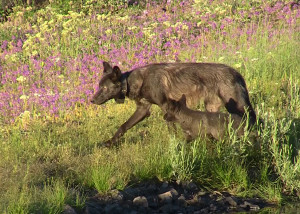By Nick Cady, Legal Director

Imnaha Pack Wolves
This past Friday, I was driving to and from Bend, over five hours in the car, to give three minutes of testimony because the Oregon Department of Fish and Wildlife (ODFW) was proposing to remove gray wolves from the state endangered species list. I was appropriately pissed given the plain fact that only 77 wolves exist in the state, but I was also feeling pretty jaded about the whole thing. I’ll explain why.
In 2011, when wolves were first returning to the state (there was 12 wolves and one breeding pair at the time), the ODFW tried to kill the male of that breeding pair and one of the sub adults from that same pack. I had passed the bar exam weeks earlier and had one lawsuit filed to my name when co-worker Josh Laughlin yelled across the office that I needed to find a way to stop this active hunt for the alpha male, OR-4.
So I started digging around. The problem was I did not have time to really conduct a thorough review as ODFW agents were out in the field hunting for the wolves as I was researching and writing. But I just starting working, and began digging around in state laws pertaining to the protection of endangered species. The gray wolf has been listed as an endangered species in the state since the passage of the law decades ago.
As it turns out the state laws did have a prohibition on taking or killing endangered species. But everyone who had been working on wolf issues, everyone who was involved in drafting the state’s wolf plan in 2005 (governor’s office, ODFW, conservationists, agricultural interests, etc.) had not given this provision any thought, when the plan purported to allow wolves to be shot in response to wolves killing livestock during the early stages of wolf recovery while they were still listed.
The reason why no one had considered this provision was that when the state Endangered Species Act was passed, the timber industry had gutted the law of any substance that could negatively impact the ability to clearcut our forests. Standard Salem politics. To be specific, the bill was clarified so that the “taking” of an endangered species, which was prohibited, does not include destruction of a species habitat. So someone would have to go out into woods and shoot a spotted owl out of a tree to violate the law, while cutting down the owl’s nest tree and clearcutting for miles in every direction was fine. Therefore, in order to violate the law, you had to directly go out and kill an endangered species. Folks thought that this was preposterous. No monster would intentionally kill an endangered species, and another meaningless law for the environment was passed by Oregon Democrats, or so they thought.
Until it came to wolves. Wolves are habitat generalists; as long as there is prey and not too many human beings around, they will survive. The real threat to wolves is people shooting and trapping them, the reason why the species was wiped out and then protected in the first place. The ridiculous contention that people might intentionally and admittedly kill endangered species had become reality in Oregon, but everyone had forgotten about the Oregon Endangered Species Act, the supposedly meaningless act of Democrat consolation to Oregon conservationists.
So I wrote a legal memo and pressed forward with the lawsuit with colleagues Oregon Wild and Center for Biological Diversity. There was a stream of late nights and Thai food drafting everything up as ODFW was actively trying to kill these wolves. And a day or so before we filed, we got word that the agency hunters had actually taken a shot at OR-4 (father of OR-7 or “Journey”), and were not sure if they had hit him or not. We quickly put everything together and filed. The Court issued us a stay later that day and ended the hunt temporarily. Ultimately, we settled the lawsuit with the state and the Oregon Cattlemen’s Association by developing stringent rules or when the state could use lethal control on wolves (more on the details of those rules here). ODFW could only now kill wolves in limited circumstances early in recovery, and when different population objectives were hit these rules would be automatically relaxed.
Organizationally, Cascadia Wildlands spent so much time and resources on this process. The settlement took almost two years to negotiate, and involved what seemed like weekly trips to Salem. It was a brutal process, but it ultimately led to an agreement that has since made Oregon the national model for responsible wolf conservation.
Turning back to my trip to Bend, and ODFW’s attempt to delist wolves, I was feeling jaded because I hoped that this landmark agreement would have bought more time before I was again taking long commutes and debating state agents and livestock producers over wolf management. I was especially upset because we had intentionally designed the wolf rules to avoid this debate over delisting. Specifically, we crafted the rules so that changes in wolf management as the population grew happen automatically and do not hinge on listing or delisting. Everyone at the table knew that the listing of wolves on the endangered species act would be incredibly controversial, so we wanted to avoid the conflict.
But apparently we were wrong, and our efforts to avoid a pointless, premature contest over delisting were in vain. Despite only having 77 wolves in the state, ODFW made recommendations to the Oregon Fish and Wildlife Commission that wolves be delisted. Although delisting would not have any management implications immediately, years down the road it could open the door to wolf hunting in the state. So we had to make the trip, organize testimony, get scientists to weigh-in and analyze the delisting proposal, because we knew the well-funded livestock lobbyists would be doing the same. I was pissed and frustrated, we had designed the rules to avoid this conflict, and ODFW launched us into it regardless. It all just seemed somewhat pointless and a waste of precious energy given all the other threats to Oregon’s environment.
After all, the wolf is just one species among many, and a species going through a successful recovery. Although the majority of the wolves and packs in Oregon are concentrated in the northeast corner of the state, wolves are beginning to disperse west. Two packs are now established in the southern Cascades, and wolves have recently been documented in the northern Cascades as well. On the other hand, spotted owl populations are crashing, sea counts of marbled murrelets indicate that numbers are plummeting, and several wetland species are now listed in the state due to disappearing habitat.
So I found myself sulking. But something happened at the meeting. As public testimony began, I starting listening to all the different voices supporting the wolf’s continued listing on the Endangered Species Act: the hydrologist testifying about the importance of wolves to aquatic ecosystems, the business lawyer testifying about the importance of liberal wildlife policies to new businesses and attracting workers, the grade school teacher presenting loads of drawings from her students about wolves, the retired ODFW employee advocating for the exercise of caution. A slew of people testified and had made the trip from all corners of the state.
I began to feel inspired. I had gotten caught up in the details of these rules and management phases, and had lost focus of what wolves and their status as an endangered species meant to the general public in Oregon. Aside from the rules and laws, wolves and the species’ recovery means so much to so many in Oregon. They are a symbol of nature and true wilderness. A species that protects the intricate web of life in our fragile ecosystems. Their recovery and the struggle to protect them is representative of the growing environmental ethic in this country.
A meeting that I went into feeling discouraged and pessimistic, turned into a reformation. A rejuvenation of enthusiasm about wolves and all they mean to the people of this state. And I was not the only one that was influenced by the public’s outcry. The Commission, despite the Department’s urgings, voted to delay any decision on delisting until later this year so that more scientific information could be gathered and analyzed. A wise decision for the Commission and the wolves. So Cascadia Wildlands will gather further evidence and analysis on the ODFW proposal as we would have regardless, but now with a renewed sense of purpose thanks to the public voices concerned with the protection of wolves. Thank you.


